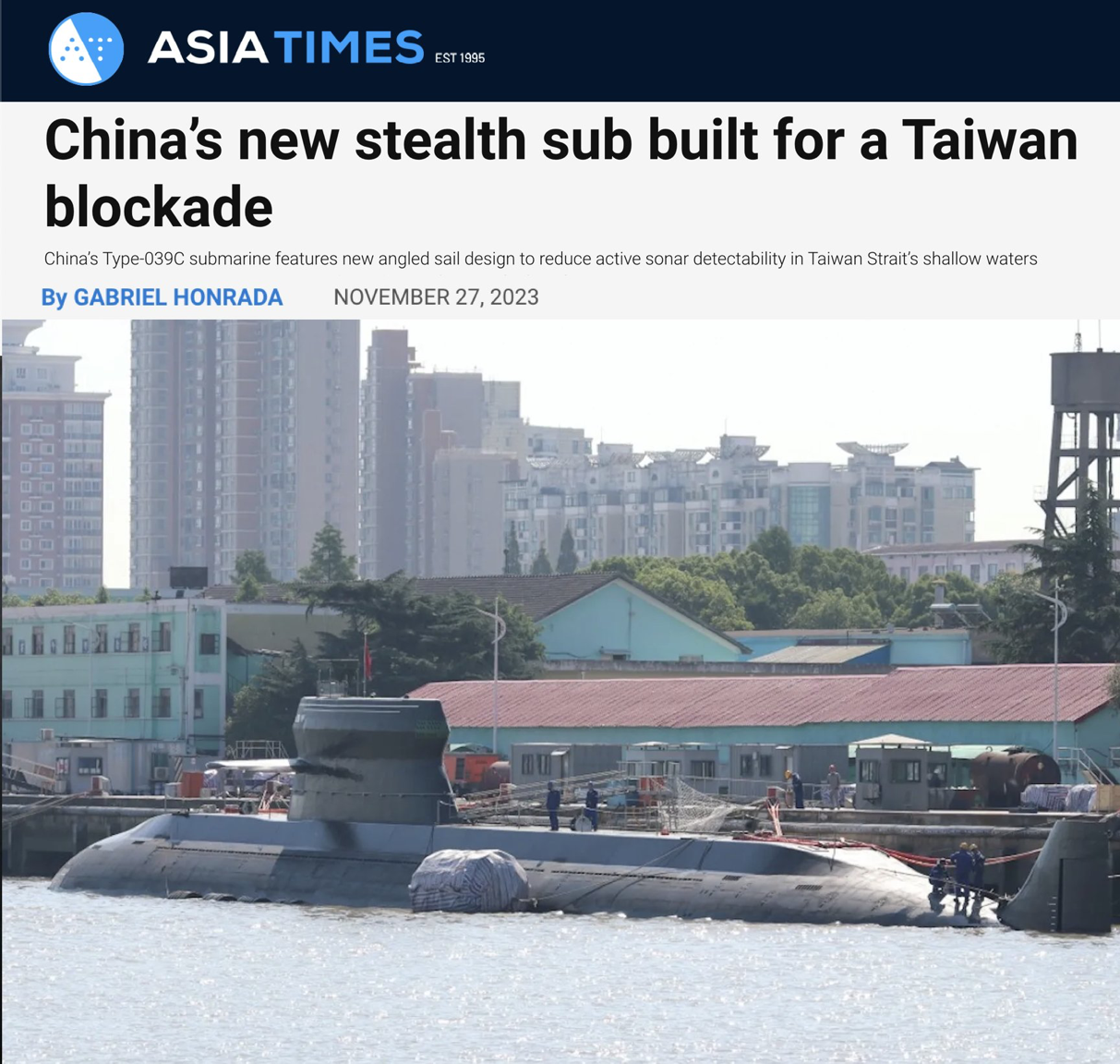China’s new stealth sub built for a Taiwan blockade
China’s Type-039C submarine features new angled sail design to reduce active sonar detectability in Taiwan Strait’s shallow waters.
China’s Type 039C Yuan-class submarine appears to mark a new era in underwater stealth technology, posing significant challenges to traditional detection tools as speculation mounts about a possible submarine-led Chinese invasion of Taiwan.
Naval News reported that the Type 039C Yuan-class submarine features an angled sail design to reduce its active sonar detectability, making it the world’s first known submarine with the feature… China’s mass production capability has made the Yuan-class the most numerous air-independent propulsion (AIP) submarine worldwide.
The use of angled stealth shaping is gaining momentum worldwide, with the upcoming Swedish A-26-class and Germany’s Type-212CD-class incorporating similar features, with the latter even encasing the whole submarine in an angled outer hull. The trend is being driven largely by the mainstream shift from using passive to active sonar, where passive detection is less effective as submarines are increasingly built to be quieter.
Naval News says that active sonar, which involves emitting a sonar signal and measuring the rebounds, is gaining in use while passive sonar, which listens for sounds emitted by a submarine, is proving less effective. The report notes that the stealth features on the Type 039C Yuan-class are designed to counter medium frequency sonars and complicate enemy classification of the vessel.
China’s Type 039C appears to represent the latest evolution of its conventional submarine designs and may already have been deployed in military exercises simulating a Taiwan blockade. China’s conventional submarine program has Taiwan in focus, as an invasion would not require nuclear-powered submarines with unlimited range in the nearby theater.
Asia Times reported in August 2022 that the Type 039C, built in Wuhan and fitted out in Shanghai, marks an evolution in conventional submarine technology using 60% newly researched and improved equipment and featuring significant system reconfiguration.
While the Type 039C features AIP technology, the specific propulsion system is unknown. Some have speculated it may employ lithium batteries, which would make strategic sense considering China manufactures three-quarters of the world’s electric vehicle (EV) batteries.
Submarines can significantly enhance their acceleration for high-speed operations and extend their underwater endurance by over two-fold with lithium-ion batteries.
The People’s Liberation Army-Navy (PLA-N) has been trying to replace traditional lead-acid batteries with lithium-ion ones for over a decade but apparently hesitated due to thermal runaway and fire risks. However, recent advancements such as using low-cost, readily available iron and phosphate can replace the usual but dangerous nickel and cobalt combination while hard carbon and ceramic coating can improve the safety of battery packaging.
The Type 039C submarine may have similar weaponry to its Yuan-class predecessors, including wire-guided torpedoes, naval mines and anti-ship missiles. It may also be capable of launching land-attack cruise missiles from its torpedo tubes.
China may already have deployed the Type 039C in August 2022 military exercises off Taiwan, simulating a submarine blockade against the self-governing island. The Type 039C and other submarines would play a vital role in a future blockade of Taiwan, as the island is believed only to have a 146-day oil stockpile and 11-day natural gas supply.
In a Taiwan blockade, conventional submarines may minimize the risk to PLA-N surface ships and aircraft, and target ships going in and out of Taiwan’s ports. A blockade may force Taiwan to capitulate without sending in an amphibious invasion force and make hiding battle losses and mission failures easier, avoiding a possible domestic backlash in China.
The US and its allies may use a convoy system and engage in anti-submarine warfare (ASW) operations east of Taiwan against a Chinese invasion. In this scenario, China wins if it sinks enough ships until the US and its allies can no longer guarantee safe access to Taiwan’s ports, and the US and its allies win if they can track down and sink a significant number of China’s submarines.
In a November 2021 article for The Warzone, Kevin Noonan notes that the US Navy may not be prepared to face the threat of China’s high-tech conventional submarines. Noonan says that since the end of the Cold War, the US Navy has yet to adapt its ASW capabilities for shallow water operations, potentially providing China an advantage in the Taiwan Strait, which is only 60 meters deep on average.
Furthermore, he says that small conventional submarines generate smaller acoustic signals, making them harder to detect, and that Chinese submarines will be essentially operating in their home waters in the Taiwan Strait, giving them a home-field advantage. He also mentions China’s submariners know how to conceal their submarines in the background noise of civilian commercial shipping, complicating their detection and targeting.
Given those challenges, the Hudson Institute notes in a July 2023 report that the US needs to change its approach to undersea warfare to emphasize uncrewed vessels. That, the report says, would enable the US and allied forces to exploit active sonar and track increasingly stealthy Chinese submarines without risking counter-detection.
